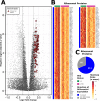RNA Sequencing of Lens Capsular Epithelium Implicates Novel Pathways in Pseudoexfoliation Syndrome
- PMID: 35348588
- PMCID: PMC8982629
- DOI: 10.1167/iovs.63.3.26
RNA Sequencing of Lens Capsular Epithelium Implicates Novel Pathways in Pseudoexfoliation Syndrome
Abstract
Purpose: Pseudoexfoliation syndrome (PEX) is a common systemic disease that results in severe and often irreversible vision loss. Despite considerable research effort, PEX remains incompletely understood. This study sought to perform the first RNAseq study in elucidate the pathophysiology of PEX, and contribute a publicly available transcriptomic data resource for future research.
Methods: Human ocular lens capsular epithelium samples were collected from 25 patients with PEX and 39 non-PEX controls undergoing cataract surgery. RNA extracted from these specimens was subjected to polyadenylated (mRNA) selection and deep bulk RNA sequencing. Differential expression analysis investigated protein-coding gene transcripts. Exploratory analyses used pathway analysis tools, and curated class- and disease-specific gene sets.
Results: Differential expression analysis demonstrated that 2882 genes were differentially expressed according to PEX status. Genes associated with viral gene expression pathways were among the most upregulated, alongside genes encoding ribosomal and mitochondrial respiratory transport chain proteins. Cell adhesion protein transcripts including type 4 collagen subunits were downregulated.
Conclusions: This comparative transcriptomic dataset highlights novel and previously recognized pathogenic pathways in PEX and provides the first comprehensive transcriptomic resource, adding an additional layer to build further understanding of PEX pathophysiology.
Conflict of interest statement
Disclosure:
Figures








References
-
- Schlötzer-Schrehardt U, Naumann GOH.. Ocular and systemic pseudoexfoliation syndrome. Am J Ophthalmol. 2006; 141(5): 921–937. - PubMed
-
- Ringvold A. Epidemiology of the pseudo-exfoliation syndrome. Acta Ophthalmol Scand. 1999; 77(4): 371–375. - PubMed
-
- Puska P, Tarkkanen A.. Exfoliation syndrome as a risk factor for cataract development: five-year follow-up of lens opacities in exfoliation syndrome. J Cataract Refract Surg. 2001; 27(12): 1992–1998. - PubMed
Publication types
MeSH terms
LinkOut - more resources
Full Text Sources

